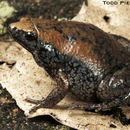en
names in breadcrumbs


The skin of G. carolinensis is smooth which is not a common characteristic amongst other varieties of toads. Most toads have rough skin that is usually lumpy in appearance and skin texture.
US Federal List: no special status
CITES: no special status
IUCN Red List of Threatened Species: least concern
Development - Life Cycle: metamorphosis
The diet of the Eastern Narrowmouth Toad consists mostly of insects like beetles, termites, and especially ants. This toad has been found feeding right at the openings to anthills.
The Eastern Narrowmouth Toad or Gastrophryne carolinensis can be found throughout the entire southeastern portion of North America and the Florida Keys. Their range extends into eastern Texas and Oklahoma. They have also been introduced to the Bahamas (Conant and Collins, 1998).
Biogeographic Regions: nearctic (Native )
Gastrophryne carolinensis has a wide variety of habitats with only two requirements. These are shelter and moisture. Narrowmouth toads are very good burrowers, and therefore may be abundant in an area without leaving any visable signs. These toads can be found by over turning boards, logs, or other shelters. Also, they can be found in vegetable debris or sawdust piles (Conant and Collins, 1998). Another place that narrowmouth toads can be found is just under the surface of suburban lawns that are abundant in sand and are watered often (Bartlett, 1999).
Terrestrial Biomes: forest
Average lifespan
Status: captivity: 6.1 years.
Average lifespan
Status: captivity: 6.0 years.
One distinguishing characteristic of G. carolinensis is the fold of skin that runs across the head directly behind their eyes. This flap of skin can fold forward to remove insects that are attacking the eyes. Color varies depending on the habitat. They can range from light tan to brown, red, and even nearly black. They have a broad dark middorsal area with light strips that are commonly covered by patches, spots, and mottlings of dark or light pigment. The stomach is strongly mottled. They also lack a tympanum. The body of G. carolinensis is round with a narrow head that is sharp and pointed, and has a small mouth. There is sexual dimorphism in color. Males have a darkly pigmented throat whereas females do not. (Conant and Collins, 1998)
Tadpoles of G. carolinensis are black and have flecks of dark blue. They also may have a tan lateral line. The tailfins have dark specks on them, as well as dark tips (Bartlett, 1999).
Other Physical Features: ectothermic ; bilateral symmetry
Breeding sites are usually in shallow water, but deep water is also used if covered by a mat of floating vegetation. These breeding sites can be anything from shallow ditches, to semipermanent ponds and irrigated agricultural areas. Rains initiate their breeding season, which may occur between early April and October in the south or midsummer in areas farther to the north. Most often the narrowmouth toad will call from the grasses surrounding the breeding pool. The male also will sometimes call the female while floating in the water, although it is more rare.
Eggs are deposited in small floating clusters, and up to 800 eggs have been reported coming from a single female (Bartlett, 1999).
Key Reproductive Features: gonochoric/gonochoristic/dioecious (sexes separate)
Average age at sexual or reproductive maturity (male)
Sex: male: 365 days.
Average age at sexual or reproductive maturity (female)
Sex: female: 547 days.